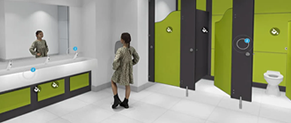Commercial Shower Valves
Commercial Shower Valves: Sensory, Non-Concussive and more
Choose from a range of push button, lever or sensor operated shower control valves designed for use with our selection of commercial shower heads.
The shower valves are designed for use in modern commercial shower environments and boast vandal resistance and water economy benefits. Electronic control systems are also available with non-touch controls which promote increased levels of hygiene.
Looking for a product that you can’t see on our website? Please send us an email or give us a call and we’ll see if we can help you find what you need.
Shower valve FAQ
What is a shower valve?
A shower valve sits within your bathroom wall and controls both the flow and temperature of water to your shower.
How does a thermostatic shower valve work?
Thermostatic shower valves mix together hot and cold water to a temperature that you have selected and can change the temperature or pressure of the water in an instant by making adjustments to the amount of hot and cold water which is allowed to flow through.
Having a thermostatic shower valve is also beneficial because it prevents scalding so is safer, particularly for children, elderly and disabled users.
How to install a concealed shower valve
Note: you should only attempt this if you have expertise and experience in plumbing. We advise that you seek a qualified plumber to complete this installation to prevent any damage.
Concealed shower valves are ideal for more compact bathrooms, offering a more tidy look. Here is how to install a concealed shower valve:
Turn off your water supply
Before you attempt any work, make sure that you have turned off your water supply and flushed your water system.
Remove your current shower valve
Once you have removed your current shower valve you will need to strip the wall down to the brick beneath. You can then measure out your ‘new wall’ with channels for both the hot and cold materials and the concealed mixer valve.
Direct the plumbing
At this stage you should ensure that your pipes pass through the backboard so they are held in place when plasterboard is put over them. You may need to install tee junctions for your hot and cold water if your piping doesn’t have them.
Make sure your plumbing is stable
You will need to use the right pipe clamps and ensure everything is fitted well and securely. If your shower valve comes with any mounting brackets, you should use these as they will prevent anything from moving about when it shouldn't!
Install your plasterboard
This is the stage where you need to be careful not to move any pipework about so please make sure everything is secured and mounting brackets have been used if necessary.
Apply panels or wall tiles
You can now decorate your bathroom wall however you wish - tiles and panels are ideal for preventing water damage to the wall when you use your shower.
Are shower valves interchangeable?
You may not always be able to mix manufacturers and interchange shower valves so you will need to look at the trim of the valves.
How to stop a leaking shower valve
A leaking shower valve can cause water damage to your walls and you may need to replace tiles and panels as a result. More severe leaks can even cause damage to flooring and other parts of your house if not treated.
In order to stop a leaking shower valve, turn off your main water supply, contact a plumber who will inspect your shower valve and have work completed to fix or replace your faulty shower valve.
How high to mount shower valve
How high you decide to mount your shower valve may depend on personal preference and your height. That said, shower valves are typically installed between 38 and 45 inches from the ground. If your shower is also a bathtub, it is recommended that the valve is between 8 and 18 inches above the bathtub.
Which shower valve should I get?
When deciding which shower valve is right for you, you should consider the following:
-
If you want a manual or thermostatic shower valve - it is important to consider who will be using the shower as thermostatic valves are generally recommended when users include children, the elderly or the disabled. This is because they are safer and prevent scalding as they will turn off the water flow when the temperature gets too hot.
-
If you want your shower valves hidden - concealed shower valves may be for you if you want the majority of your shower unit hidden. Whilst shower controls are visible, the remainder is located behind the wall and can be considered more modern and stylish. If you don’t mind your shower valve being visible, exposed shower valves such as bar shower valves are also common.
-
If you want a digital shower valve - these smart and modern shower valves allow you to make precise temperature adjustments to suit your liking!
If you would like some advice on shower valves, get in touch with our friendly team today.





